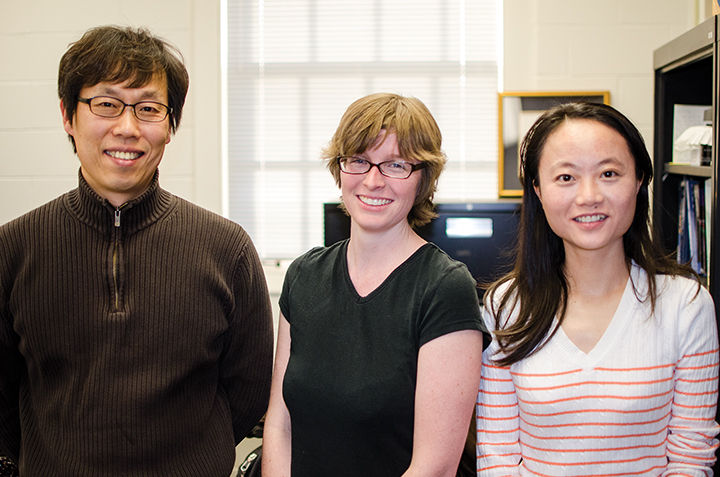
Professor Sang Bok Lee, and doctorate students Eleanor Gillette and Chanyuan Liu pose for a portrait after discussing the nanobattery they are working on.
Typical batteries are big, overcomplicated and slow to charge, but university researchers have developed their own batteries they say combine form and function for greater use and research.
These batteries have a simple structure, which means they take on charge quickly, and each one is thousands of times smaller than a human hair.
In a paper published in Nature Nanotechnology last month, scientists and engineers at this university demonstrated how they built working batteries on the nanoscale using a structure called nanopores, which are ceramic membranes with billions of pores in every square centimeter.
In each of these pores lies a miniscule battery.
Batteries of such a size are worth studying in their own right, said Chanyuan Liu, the lead author of the study, but their small size and straightforward design actually make them very efficient at holding charge.
“We’re using traditional materials,” said Liu, a doctoral student in materials science at this university, “but because we’re using these nanoscale alignments of each nanopore and connect[ing] them in parallel, this enables … a short distance between two electrodes in a straight channel, and that enables the very fast charging of our battery.”
Classic batteries — everything from AA batteriesto the ones in cars — are arrays of circuits and resistors. Electrons pass between an anode and a cathode, carrying the charge through the battery for its use. These nanopore batteries work in the same way, said Sang Bok Lee, a co-author of the study, but without the need for inefficient resistors.
Instead, within each nanopore is an anode and a cathode, and lithium ions can follow only one path, the simplest one possible — straight from one end to the other, said Lee, a university chemistry professor.
“In this single nanopore, we confine ion movements in this small, nanoscale space,” he said. “So ions cannot really escape from these nanopores. It is traveling between two electrodes in this confined nanospace.”
The U.S. Department of Energy funded this research through Nanostructures for Electrical Energy Storage, an Energy Frontier Research Center that began in 2009, Gary Rubloff, a co-author of the study and university engineering and materials science professor, wrote in an email.
The researchers used a commercially available ceramic template, which has hexagonally arranged sets of pores and resembles honeycombs, said Eleanor Gillette, a co-author and chemistry doctoral student. The material is 50 microns thick — about half as thick as a human hair — and contains a billion pores for every square centimeter.
“Then we take this nice ordered template, and we turn it into a battery,” Gillette said.
This requires layering the pores atom by atom until the structure is complete, Lee said. The work takes a lot of precision, but the batteries have a lot of potential, he said. Each pore is identical to every other, and they can work together as a network.
Right now, the batteries don’t carry much charge, but Liu said the team should be able to increase the batteries’ power. They also showed that these batteries can be recharged for thousands of cycles.
And these ceramic sheets that contain the nanopores are also made in industrial sizes, meaning such batteries, with some more research, could be adopted on a much larger scale, Lee said.
The fact that these tiny batteries are so efficient could have a big impact. Because of their structure and the way they work together, these batteries could help researchers learn how batteries can be charged more quickly and efficiently, she said.
“This can kind of bridge some of the technologies out there and be able to collect a lot of charge very quickly compared to your traditional battery that you plug in all night,” she said.
This could have applications in everything from getting a phone to fully charge in 12 minutes to building regenerative braking systems. Gillette said slow charging also has been a limiting factor in the popularity of electric cars.
“Nobody wants to sit there for an hour and wait for their car to charge,” she said. “So understanding what it takes to make a faster-charging battery is really interesting, even if this one’s not quite ready for prime time.”



